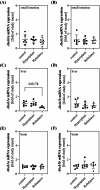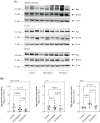St. John's Wort Extract Increases Pgp Expression in the Brain but Not in the Small Intestine or the Liver of Wistar Rats
- PMID: 40325522
- PMCID: PMC12052523
- DOI: 10.1002/prp2.70111
St. John's Wort Extract Increases Pgp Expression in the Brain but Not in the Small Intestine or the Liver of Wistar Rats
Abstract
St John's Wort (SJW), commonly used to treat mild depression, is known to pose a risk of drug-herb interactions through hyperforin-mediated activation of the pregnane X receptor (PXR). This induces transcription and expression of PXR target genes, including the efflux transporter P-glycoprotein (Pgp). While the activation of human PXR by the SJW constituent hyperforin is well established, there are contradictory findings on rodent PXR target genes. This study aimed to further investigate SJW effects on Pgp expression in rats. Male Wistar rats were treated for 10 days with the two commercial SJW formulations, Hyperiplant and Rebalance, which differ in their hyperforin content. Quantitative real-time PCR, western blot analysis, and immunohistochemical staining were applied to test for Pgp mRNA expression and protein abundance in the small intestine (jejunum), liver, and brain (cerebrum). Treatment with the hyperforin-rich Hyperiplant increased protein levels in the brain. However, it did not affect mRNA levels. Besides, there was no impact on Pgp protein abundance in the small intestine or the liver. The hyperforin-poor formulation Rebalance did not affect Pgp expression in any of the investigated tissues. Taken together, our results show that there is a modulation of brain Pgp protein abundance in Hyperiplant-treated animals. As such, we conclude that the inducing effect is governed by a so far unknown regulatory mechanism that most likely does not affect transcription of the transporter.
© 2025 The Author(s). Pharmacology Research & Perspectives published by British Pharmacological Society and American Society for Pharmacology and Experimental Therapeutics and John Wiley & Sons Ltd.
Conflict of interest statement
The authors declare no conflicts of interest.
Figures




Similar articles
-
St. John's Wort Formulations Induce Rat CYP3A23-3A1 Independent of Their Hyperforin Content.Mol Pharmacol. 2023 Dec 15;105(1):14-22. doi: 10.1124/molpharm.123.000725. Mol Pharmacol. 2023. PMID: 37863663
-
Functional induction and de-induction of P-glycoprotein by St. John's wort and its ingredients in a human colon adenocarcinoma cell line.Drug Metab Dispos. 2005 Apr;33(4):547-54. doi: 10.1124/dmd.104.002485. Epub 2005 Jan 7. Drug Metab Dispos. 2005. PMID: 15640377
-
St. John's wort extract with a high hyperforin content does not induce P-glycoprotein activity at the human blood-brain barrier.Clin Transl Sci. 2024 May;17(5):e13804. doi: 10.1111/cts.13804. Clin Transl Sci. 2024. PMID: 38700454 Free PMC article.
-
Understanding drug interactions with St John's wort (Hypericum perforatum L.): impact of hyperforin content.J Pharm Pharmacol. 2019 Jan;71(1):129-138. doi: 10.1111/jphp.12858. Epub 2018 Feb 7. J Pharm Pharmacol. 2019. PMID: 29411879 Review.
-
Protective Role of St. John's Wort and Its Components Hyperforin and Hypericin against Diabetes through Inhibition of Inflammatory Signaling: Evidence from In Vitro and In Vivo Studies.Int J Mol Sci. 2020 Oct 30;21(21):8108. doi: 10.3390/ijms21218108. Int J Mol Sci. 2020. PMID: 33143088 Free PMC article. Review.
References
MeSH terms
Substances
Grants and funding
LinkOut - more resources
Full Text Sources
Research Materials
Miscellaneous

